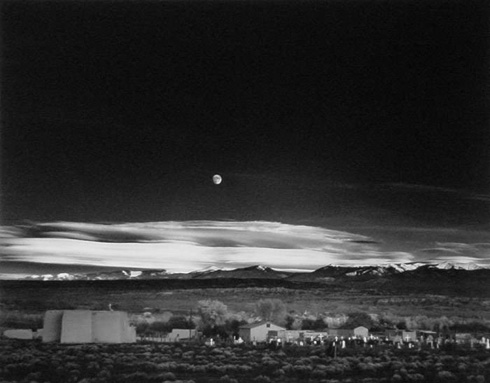It was a slightly cloudy day.
It was on this day, in 1941, that a photograph which over the years has attained
iconic status was taken. Ansel Adams's photograph "Moonrise, Hernandez, New
Mexico, 1941" has been reproduced countless times. It's rightfully considered
a classic.
When Adams saw this scene, he knew that it had to be photographed.
The story of the taking of the photograph can be found on a
page of the website of Housatonic Museum of Art. On that same page we can
learn how, though it was apparently well known that Adams wasn't particularly
meticulous about dating his photographs, the date of this moonrise was determined:
Adams said he often disregarded the dates of his negatives,
causing dismay among historians. Moonrise was dated anywhere between 1940 and
1944. "Dr. Elmore of the High Altitude Observatory at Boulder, Colorado, put a
computer to work on the problem. Using data from a visit to the site, analysis
of the moon's position in the photograph, and lunar azimuth tables, he determined
that the exposure was made at approximately 4:05 P.M. on October 31, 1941."

This photograph
also carries the weight of history. Not only is it a very well known image - it
is also among those best known for being doctored. The story of that doctoring
appeared in the Boidem, as is to be expected, in a very different context, four
and a half years ago, quoted from the May, 1998 Atlantic Online article Photography
in the Age of Falsification by Kenneth Brower: In
his first years of printing his most famous photograph, Moonrise, Hernandez,
New Mexico, 1941, Ansel Adams, in his words, "allowed some random clouds
in the upper sky area to show." They always annoyed him, and in the 1970s
he arranged in the darkroom for those clouds to evaporate. In his celebrated Winter
Sunrise, The Sierra Nevada From Lone Pine, California, Adams deleted from
the dark foothills of the middle ground the big "LP" that the little
town's high school students had laid out in whitewashed stones.
Although
the photograph may not be a totally accurate representation of Hernandez at that
moment on that particular day, it should probably be considered an accurate representation
of what Adams saw. And of course doctoring in the name of art probably
can't be considered a vice.
Go to: The friend of a friend of a friend of ...
